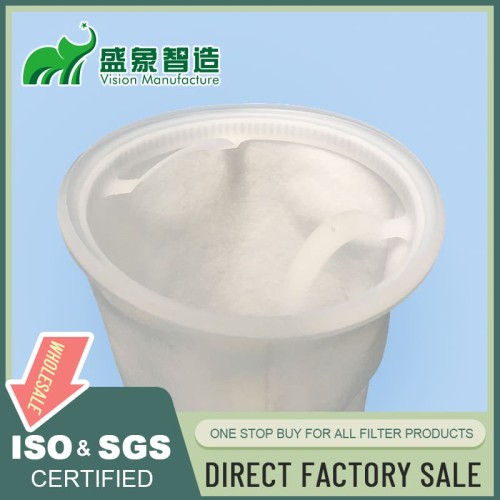
200 Micron Filter Bags Optimize Coarse Particle Removal in Industrial Processes
I. Introduction
In industrial filtration, managing coarse particles effectively is crucial for maintaining system efficiency and protecting sensitive components. This introduction discusses the role of 200 micron filter bags, which are instrumental in streamlining filtration across various industries due to their balance of efficiency and functionality.
II. Understanding 200 Micron Filtration
A 200 micron filter bag is designed to capture particles that are 200 micrometers in diameter, providing effective coarse particle filtration. This section will clarify:
- Micron Rating Explained: Understanding the particle size that these bags are capable of filtering.
- Particle Size Perspective: Discussing how these bags perform in removing contaminants from various media.
- Filtration Efficiency at 200 Micron Level: Evaluating the effectiveness of these bags in capturing and retaining particles.
III. Types of 200 Micron Filter Bags
200 micron filter bags are available in various materials and constructions to suit different filtration needs:
- Material Options: Including polyester, polypropylene, and nylon, each offering unique benefits.
- Construction Methods: Options such as sewn and welded, which affect the durability and performance of the bags.
- Size and Shape Variations: Ensuring a fit for a wide range of filtration systems.
IV. Applications Across Industries
These filter bags are utilized in numerous sectors due to their robust filtering capabilities:
- Water and Wastewater Treatment: Essential for pre-filtering to remove large particulates before finer filtration stages.
- Chemical Processing: Used to filter out impurities that can affect product quality.
- Food and Beverage Production: Critical for maintaining clarity and quality in consumables.
- Oil and Gas Industry: Filters out coarse debris in extraction and processing operations.
- Paint and Coatings Manufacturing: Ensures smooth finishes by capturing aggregates and particulates.
- Agricultural Irrigation: Helps in managing water quality for irrigation purposes.
V. Key Features and Benefits
The benefits of using 200 micron filter bags include:
- High Flow Rates: Allows for the efficient processing of large volumes of fluid.
- Good Dirt-Holding Capacity: Can accumulate substantial amounts of particulate matter.
- Extended Service Life: Durable materials and construction extend the operational lifespan.
- Cost-effectiveness: Offers a practical solution that balances performance with expense.
- Versatility Across Applications: Suitable for a wide range of industrial applications.
VI. Material Selection Criteria
Selecting the right material for 200 micron filter bags involves understanding:
- Chemical Compatibility: Ensuring the material is suitable for the chemical composition of the fluid.
- Temperature Resistance: Matching the bag’s capabilities with the system’s temperature requirements.
- Abrasion Resistance: Choosing materials that can withstand physical wear.
- Durability and Lifespan: Considering materials that offer longevity under typical use conditions.
VII. Design Considerations
Effective design is crucial for maximizing the performance of 200 micron filter bags:
- Bag Dimensions and Capacity: Tailored dimensions to fit specific housings or applications.
- Seam Types and Strength: Ensuring robust construction to prevent failures.
- Surface Treatments: Enhancements like coatings to improve filtration efficiency and ease of cleaning.
- Attachment Methods: Features that ensure secure and straightforward installation.
VIII. Performance Characteristics
Key performance metrics for 200 micron filter bags include:
- Flow Rate Capabilities: The volume of fluid that can be processed efficiently.
- Pressure Drop Profiles: Minimal impact on system pressure, enhancing overall efficiency.
- Particle Retention Efficiency: High effectiveness in trapping targeted particulates.
- Service Life Expectations: Longevity of the bags under typical operating conditions.
IX. Installation and Maintenance
Proper installation and regular maintenance are crucial for maximizing the performance of 200 micron filter bags:
- Proper Installation Techniques: Ensuring correct placement to prevent bypass and ensure optimal filtration.
- Break-in Procedures: Essential steps to prepare the bags for long-term operation.
- Cleaning and Regeneration Methods: Maintaining cleanliness to sustain performance.
- Replacement Guidelines: Timely replacement to maintain filtration efficiency.
X. Comparative Analysis
Understanding the advantages of 200 micron filtration over other options involves:
- 200 Micron vs. Finer Filtration Grades: Assessing when finer grades are necessary based on specific application needs.
- Advantages Over Coarser Filters: The benefits of more precise filtration in protecting downstream components.
- Cost-Benefit Analysis in Various Applications: Evaluating the economic impacts of using 200 micron bags.
XI. Environmental Considerations
The sustainability of using 200 micron filter bags is underscored by:
- Recyclability of Filter Materials: Promoting the use of materials that can be recycled to minimize environmental impact.
- Energy Efficiency: Enhancing the energy efficiency of filtration processes.
- Waste Reduction Strategies: Implementing measures to reduce waste in filtration operations.
XII. Case Studies
Real-world applications demonstrate the effectiveness of 200 micron filter bags in various settings, showcasing their ability to solve complex filtration challenges and deliver significant improvements in performance and operational efficiency.
XIII. Future Trends
Emerging technologies and trends are set to enhance the capabilities of 200 micron filter bags:
- Advanced Materials: Developments in filter media that offer improved durability and filtration efficiency.
- Smart Filtration Solutions: Integration with sensors to optimize performance and predict maintenance needs.
XIV. Conclusion
200 micron filter bags play a crucial role in industrial filtration, offering a practical solution that balances efficiency with flow rate management. As industries continue to seek robust and cost-effective filtration solutions, these bags stand out as a preferred choice. For further exploration of how these innovative solutions can optimize your processes, consider reaching out for expert consultation.
Leave a comment

